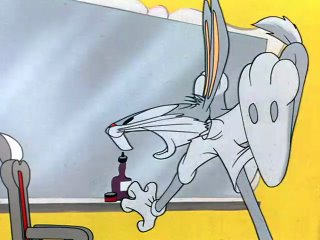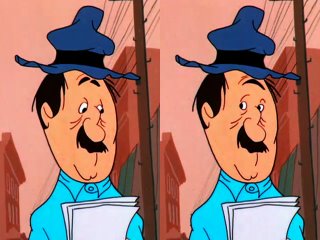
Exaggeration is a very important principle in animation - after all, we're trying to caricature and distill life to it's clearest essence, not reproduce it verbatim. But many students often misunderstand the meaning of exaggeration; they think it always means "bigger" or "faster" or "broader". Not so! It can also mean "smaller", "slower" or "subtler". The key is the "-er": figure out the adjectives that describe the attitudes and actions in your shot, then try to make them "more" like that by adding "er" to the end of the adjectives.
If every pose and action in a performance is extreme then none of them are - the texture becomes even and the audience gets bored. It's important to have big moves AND small moves, fast ones AND slow ones. By varying these elements you give variety to your scene and place emphasis where it needs to be. If you've got three big changes and one small change, the small one will stand out.
The late Chuck Jones was a master of exaggeration. He could achieve more impact with a single eyebrow raise than a lot of animators could with a full-body take. Just look at his work on How The Grinch Stole Christmas and his later Warner Brothers shorts. He knew that less could be much more. He could exaggerate the stillness of a character's pose, so that a change would be isolated to a single small part of the character; perhaps a single muscle. He made a trademark of having a character hold a pose and just glance at the camera with his eyes, as if to say, "what the...?"

So the next time your planning and animating a character, think of ways to make it "er"!
Bravo! One of my favorite shots is the one Tony Fucile did for the Incredibles trailer. The one with absolutely no movement in it at all.
ReplyDeleteAwesome reminder. Its so easy to push and push and in the end realise its all pushed to broad big movements. Good contrast, so easy to forget :]
ReplyDeleteThanks!
Ha ha, that is a great way to think about it! I love your comments about "-er". Great advice, keep it coming!
ReplyDeleteThanks a lot for sharing your knowledge, this is also the mark of the true great animators.
ReplyDeleteThank you very much for sharing this tidbit of knowledge with us, sir! I, myself, am an aspiring artist, so any information on the subject is greatly appreciated.
ReplyDelete-- Mitch
Hello sir,
ReplyDeleteI must say that you have given an excellent example about exaggeration over here, i just have one query when you mention about planning, what all things you always take in consideration while planning, apart from thumbnails and video reference, like what other aspects do you consider like for eg: breakdowns or anything else in specific, and how much time do you spend on planning.
Thank you very much for your help sir.
Regards,
Chintan.
chintan shah, I usually try to spend at least one day planning a shot, depending on how long I have to complete it and how complex the shot is. I can't go into a whole lot of detail about my planning process in this comment section, but you can read some of my thoughts about it here:
ReplyDeletehttp://www.strutyourreel.com/forum/viewtopic.php?t=1755&postdays=0&postorder=asc&start=60
Hello Sir,
ReplyDeleteI just read the article, thank you so much for sharing this important knowledge with us.
You Rock (\../)
Chintan Shah
A very useful 'exaggeration' reminder indeed! It's so very important in animation. Chuck Jones was truly a genius and a master. Thank you so much!
ReplyDeletevery informative and enlightening tips, thanx so much!! :o)
ReplyDeleteThank you very much for this article Mr. Navone!
ReplyDeleteI'm an experienced animator and I often tried to study old cartoons such as Chuck Jone's but I can never pay attention to anything in particular. I knew it was great animation, but without focusing on any precise element of it, i just get swalloed by it's entertainment value and watch the cartoons like a 3 years old boy.
(... might be why you work at Pixar and I'm not...)
You explained your point very well and illustrated it masterfully with your choice of pictures!
This is the kind of articles that connect very well with my picky brain and i should apply this to my animation.... wait for it ..... now!
Thanks again for sharing your knowledge, experience and observations!
Oh yes, I got this principle misunderstood also. Good thing you made it clearer for us. And the -er really helps! Thanks!
ReplyDeleteFinally, my thoughts on exagg has been cleared enough. Thanks so much! Thanks too for the "-er" tip. Now it keeps reverberating on my head. ^_^
ReplyDelete-Reyn